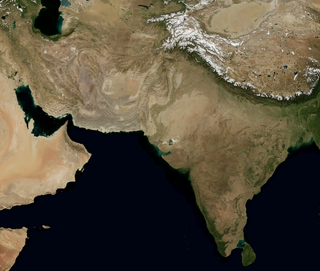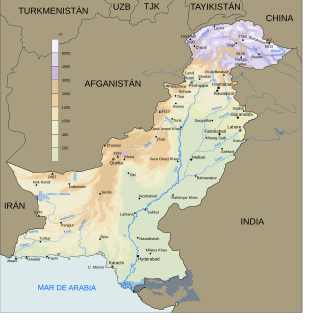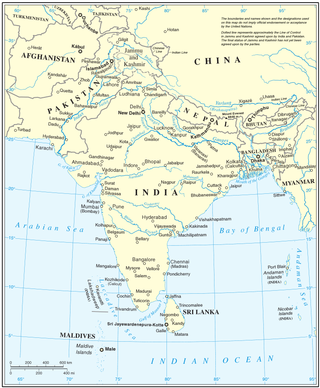 Location of Afghanistan and Pakistan | |
| Date | August 2013 |
|---|---|
| Location | |
| Deaths | 187 |
In August 2013, Pakistan and eastern Afghanistan experienced heavy rain that led to flash flooding. More than 180 died as a result of the floods. [1]
 Location of Afghanistan and Pakistan | |
| Date | August 2013 |
|---|---|
| Location | |
| Deaths | 187 |
In August 2013, Pakistan and eastern Afghanistan experienced heavy rain that led to flash flooding. More than 180 died as a result of the floods. [1]
Pakistan and eastern Afghanistan are frequently hit by flooding during the monsoon season. Since 2010, the region has suffered devastating floods that have left hundreds dead each year. [2] The worst flooding in the past 80 years occurred in 2010, when flooding in Pakistan resulted in more than 1,700 deaths and widespread damage. [3]
Beginning 31 July 2013, Pakistan and parts of eastern Afghanistan experienced unusually heavy rainfall that caused widespread flash flooding. Flood waters began to recede on 5 August, but more heavy rain was expected later in August and September, the heart of monsoon season. [3] All but one area of Khyber Pakhtunkhwa province in Pakistan was flood-free by 5 August, as the waters receded almost as quickly as they had risen. [4]
In Pakistan 80 deaths were reported as of 5 August; more than 30 other people were injured. [1] The death toll rose to 83 as of 13 August with more than 94 injured. [3] [5] Casualties spanned the country, with the city of Karachi in south Pakistan being the hardest hit. In the northwest, 12 deaths were reported in the tribal region, eight in Khyber Pakhtunkhwa province, and three in the Kashmir region. [6] Fast moving water washed away many houses in the region. [2] In central Pakistan, 12 deaths were reported in Punjab province. In the south, eight deaths were reported in Sindh and ten in Baluchistan. [6] Across Pakistan, more than 66,000 people were affected by the rain and resulting floods. [3] Many of the deaths were the result of collapsed houses or by electrocution from downed power lines. In Karachi, poor neighbourhoods experienced waist-deep flooding and widespread power outages. [1] Drainage and sewage systems in the city were clogged, causing the streets to fill with water. [3]
Mountainous regions in eastern and southeastern Afghanistan were the main areas hit by floods. In the rural Surobi District 61 people were killed, and around 500 mudbrick homes were washed away across more than a dozen villages. In the provinces of Khost and Nangarhar, flooding destroyed 50 houses and thousands of acres of farm land. 24 deaths were reported in the area. In the province of Nuristan at least 60 homes were destroyed across three districts, but no casualties were reported. [1] On 10 August, at least 22 more people killed in the flash flood near Kabul [7] As of 14 August death toll rises above 90 in the country.
Nawaz Sharif, Pakistan's Prime Minister, sent three cabinet ministers to survey affected areas. National Disaster Management Authority chief Muhammad Saeed Aleem blamed global climate change for the floods. [3] In eastern Pakistan, 100 trucks carrying relief supplies were dispatched, and 30 medical camps were established. [4] Officials in Karachi said it would take at least two days to clean up after the floods receded. [3] The army was deployed to Karachi where army engineers worked to pump out the blocked drainage systems. [4]
Officials in Afghanistan said they were unable to deliver aid to some hard hit areas due to the access roads being controlled by the Taliban insurgents. [1]
On 5 August, United Nations spokesperson Martin Nesirky said UN and its humanitarian partners are ready help Afghanistan and Pakistan if required. [8]

Khyber Pakhtunkhwa commonly abbreviated as KP or KPK, is one of the four provinces of Pakistan. Located in the northwestern region of the country, Khyber Pakhtunkhwa is the smallest province of Pakistan by land area and the third-largest province by population after Punjab and Sindh. It shares land borders with the Pakistani provinces of Balochistan to the south, Punjab to the south-east and province of Gilgit-Baltistan to the north and north-east, as well as Islamabad Capital Territory to the east, Autonomous Territory of Azad Jammu and Kashmir to the north-east. It shares an international border with Afghanistan to the west. Khyber Pakhtunkhwa is known as a tourist hot spot for adventurers and explorers and has a varied landscape ranging from rugged mountain ranges, valleys, plains surrounded by hills, undulating submontane areas and dense agricultural farms.

The Geography of Pakistan is a profound blend of landscapes varying from plains to deserts, forests, and plateaus ranging from the coastal areas of the Arabian Sea in the south to the mountains of the Karakoram, Hindukush, Himalayas ranges in the north. Pakistan geologically overlaps both with the Indian and the Eurasian tectonic plates where its Sindh and Punjab provinces lie on the north-western corner of the Indian plate while Balochistan and most of the Khyber Pakhtunkhwa lie within the Eurasian plate which mainly comprises the Iranian Plateau.

Pakistan's climate is a continental type of climate, characterized by extreme variations in temperature, both seasonally and daily, because it is located on a great landmass north of the Tropic of Cancer.

The 1989 North Indian Ocean cyclone season was a below-average season in annual cycle of tropical cyclone formation. The season has no official bounds but cyclones tend to form between April and December. These dates conventionally delimit the period of each year when most tropical cyclones form in the northern Indian Ocean. There are two main seas in the North Indian Ocean—the Bay of Bengal to the east of the Indian subcontinent and the Arabian Sea to the west of India. The official Regional Specialized Meteorological Centre in this basin is the India Meteorological Department (IMD), while the Joint Typhoon Warning Center (JTWC) releases unofficial advisories. An average of five tropical cyclones form in the North Indian Ocean every season with peaks in May and November. Cyclones occurring between the meridians 45°E and 100°E are included in the season by the IMD.

The 2010 Salang avalanches consisted of a series of at least 36 avalanches that struck the southern approach to the Salang Tunnel, north of Kabul. They were caused by a freak storm in the Hindu Kush mountains.
Events from the year 2010 in Pakistan.
These are the list of Terrorist attacks in Pakistan in 2010.
Events in the year 2014 in Pakistan.
The following lists events from 2014 in Afghanistan.
The following lists events that happened during 2016 in Pakistan.
Widespread monsoon flooding occurred in the South Asian countries of Afghanistan, Bangladesh, India, Nepal and Pakistan from July through September 2017. More than 45 million people were affected by the floods, including 16 million children.
From February to April 2019, widespread flash flooding affected large parts of Pakistan, most severely in Balochistan, KPK, Punjab, and other provinces. Pakistan has been hit by three major waves of rain and flooding over the course of more than one month. The first wave of rain began on 20 February, leading to flooding in to Khyber and Balochistan, therefore many villages and several cities have been evacuated, and more than 1,500 families has been rescued alone in Balochistan and many in other states. The 20 February rain and thunderstorms caused flash floods in the Lasbela area. The main areas affected were Turbat, Tump, Nasirabad and Dasht where 300 people were displaced due to the flood. These people were then moved to camps established by the Provincial Disaster Management Authority (PDMA). Casualties have came mostly due to roof collapsing amid heavy rains and flash flooding. Khyber Pakhtunwkha has witnessed the most deaths till now, 40, alongside Balochsitan has faced 26 casualties with more than 9 in Punjab and other places. Due to rain, flood and storm casualties are increasing.
The 2020 Karachi floods were the worst flooding Karachi had seen in almost a century, and killed at least 41 people across Pakistan. The floods were caused by record monsoon rains, which were inadequately drained by poorly maintained drainage systems in the city. The resulting floods caused deaths and destruction of infrastructure and properties in the city.

In 2016 Pakistan experienced higher rainfall than normal (10-20%), especially in the pre-monsoon season. Heavy monsoon rains are common in the region. This led to multiple periods of flooding, landslides, and damage particularly in Northern Pakistan. The Swat River overflowed and multiple landslides occurred around Pakistan including in Khyber Pakhtunkhwa, Gilgit-Baltistan, Azad Jammu, and Kashmir.

From January to October 2022, excessive rainfall and widespread monsoon flooding occurred in the South Asian countries of Afghanistan, Bangladesh, India, Nepal, Pakistan, and Sri Lanka. It has become the region's deadliest floods since 2020, with over 3,700 people dead.

After over 6,500 people died in flooding in 2020, monsoon floods hit South Asia again in 2021.

Monsoon floods have affected South Asia from May to December 2019.